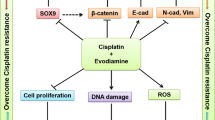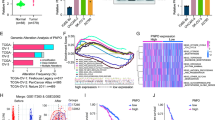Abstract
The aim of this study was to determine the relationship and underlying mechanisms between ectopic expression of phosphatidylethanolamine-binding protein 4 (PEBP4) and cisplatin (DDP)-induced cytotoxicity in the lung cancer cell line A549 to provide an experimental basis for future chemotherapeutic applications involving PEBP4 in human lung cancer. A recombinant plasmid, pcDNA3-PEBP4, and a PEBP4-targeting small hairpin RNA (shRNA) were transfected into the lung cancer cell line A549. The PEBP4 protein expression levels were determined for each group by Western blot, and after 48 h of cisplatin (DDP) treatment, the viability of cells in the treatment and control groups was determined by 3-[4,5-dimethylthiazol-2-yl]-3,5-diphenyltetrazolium bromide (MTT) assay. Apoptosis in each treatment group was determined using flow cytometry. Western blotting was used to examine expression of the p53 protein in A549 cells from each group. We employed a luciferase reporter-gene assay to confirm PEBP4 as a target gene of miR-34a. Western blotting was used to determine the effects of miR-34a on PEBP4 protein expression in A549 cells. Following transfection of A549 cells with either the recombinant plasmid pcDNA3-PEBP4 or a PEBP4-targeting shRNA, Western blotting analyses showed PEBP4 protein expression was significantly higher in the pcDNA3-PEBP4-transfected group compared with the control or PEBP4-shRNA-transfected groups (p < 0.01). Furthermore, PEBP4 protein expression was significantly reduced in the PEBP4-shRNA-transfected group (p < 0.01). After 48 h of DDP treatment, MTT assays indicated that A549 cell viability was significantly lower in the DDP-treated group compared with the control group (p < 0.01). The viability of A549 cells in the pcDNA3-PEBP4-transfected group was lower than that in the control group (p < 0.05) but higher than that in either the DDP-treated or PEBP4-shRNA-transfected groups (p < 0.05). Moreover, the viability of A549 cells in the PEBP4-shRNA-transfected group was significantly lower than that in either the control (p < 0.01) or DDP-treated (p < 0.05) groups. Flow cytometry and Western blotting analyses indicated that the number of apoptotic cells and p53 protein expression were significantly higher in the DDP-treated group compared with the control group (p < 0.01). In the pcDNA3-PEBP4-transfected group, the number of apoptotic cells and p53 protein expression level were higher than those in the control group (p < 0.05) but lower than those in the DDP-treated and PEBP4-shRNA-transfected groups (p < 0.05). The number of apoptotic cells and p53 protein expression level in the PEBP4-shRNA-transfected group were higher than those in the control (p < 0.01) and DDP-treated (p < 0.05) groups. The luciferase reporter-gene assay showed that the relative luciferase activity after transfection with a miR-34a mimic was significantly reduced compared with the control group (p < 0.01). Western blotting analysis demonstrated that PEBP4 protein expression was significantly decreased in A549 cells 48 h after transfection with a miR-34a mimic compared with the control group (p < 0.01). In conclusion, overexpression of PEBP4 reduced the sensitivity of A549 cells to DDP-induced cytotoxicity, mainly through the altered expression of the p53 protein or the modulation of miR-34a.






Similar content being viewed by others
References
Marshall HM, Bowman RV, Yang IA, Fong KM, Berg CD. Screening for lung cancer with low-dose computed tomography: a review of current status. J Thorac Dis. 2013;5:S524–39.
Wakelee H. Management of early stage non-small cell lung cancer. Transl Lung Cancer Res. 2013;2:315.
Templeton AK, Miyamoto S, Babu A, Munshi A, Ramesh R. Cancer stem cells: progress and challenges in lung cancer. Stem Cell Investigation. 2014;1:99.
Chen W, Zheng R, Zhang S, Zhao P, Li G, Wu L, et al. Report of incidence and mortality in China cancer registries, 2009. Chin J Cancer Res. 2013;25:10–21.
Park BJ. Robotic lobectomy for non-small cell lung cancer (NSCLC): multi-registry study of long-term oncologic results. Ann Cardiothorac Surg. 2012;1(1):24–6.
Bar J, Urban D, Borshtein R, Nechushtan H, Onn A. EGFR mutation in lung cancer: tumor heterogeneity and the impact of chemotherapy. Chin Clin Oncol. 2013;2:2.
Zhan P, Qian Q, Wan B, Yan TD, Yu LK. Prognostic value of TTF-1 expression in patients with non-small cell lung cancer: a meta-analysis. Transl Cancer Res. 2013;2:25–32.
Bernier I, Jolles P. Purification and characterization of a basic 23 kDa cytosolic protein from bovine brain. Biochim Biophys Acta. 1984;790(2):174–81.
Garcia R, Grindlay J, Rath O, et al. Regulation of human myoblast differentiation by PEBP4. EMBO Rep. 2009;10(3):278–84.
Amaya I, Ratcliffe OJ, Bradley DJ. Expression of CENTRORADIALIS (CEN) and CEN-like genes in tobacco reveals a conserved mechanism controlling phase change in diverse species. Plant Cell. 1999;11(8):1405–18.
Erttmann KD, Gallin MY. Onchocerca volvulus: identification of cDNAs encoding a putative phosphatidyl-ethanolamine-binding protein and a putative partially processed mRNA precursor. Gene. 1996;174(2):203–7.
Wilson R, Ainscough R, Anderson K, et al. 2.2 Mb of contiguous nucleotide sequence from chromosome III of C. elegans. Nature. 1994;368(6466):32–8.
Kikuchi R, Kawahigashi H, Ando T, et al. Molecular and functional characterization of PEBP genes in barley reveal the diversification of their roles in flowering. Plant Physiol. 2009;149(3):1341–53.
Odabaei G, Chatterjee D, Jazirehi AR, et al. Raf-1 kinase inhibitor protein: structure, function, regulation of cell signaling, and pivotal role in apoptosis. Adv Cancer Res. 2004;91:169–200.
Zeng L, Imamoto A, Rosner MR. Raf kinase inhibitory protein (RKIP): a physiological regulator and future therapeutic target. Expert Opin Ther Targets. 2008;12(10):1275–87.
Keller ET, Fu Z, Brennan M. The biology of a prostate cancer metastasis suppressor protein: Raf kinase inhibitor protein. J Cell Biochem. 2005;94(2):273–8.
Sagisaka T, Matsukawa N, Toyoda T, et al. Directed neural lineage differentiation of adult hippocampal progenitor cells via modulation of hippocampal cholinergic neurostimulating peptide precursor expression. Brain Res. 2010;1327:107–17.
Yeung K, Seitz T, Li S, et al. Suppression of Raf-1 kinase activity and MAP kinase signalling by RKIP. Nature. 1999;401(6749):173–7.
Corbit KC, Trakul N, Eves EM, et al. Activation of Raf-1 signaling by protein kinase C through a mechanism involving Raf kinase inhibitory protein. J Biol Chem. 2003;278(15):13061–8.
Shemon AN, Heil GL, Granovsky AE, et al. Characterization of the Raf kinase inhibitory protein (RKIP) binding pocket: NMR-based screening identifies small-molecule ligands. PLoS One. 2010;5(5):e10479.
Yu GP, Huang B, Chen GQ, et al. PEBP4 gene expression and its significance in invasion and metastasis of non-small cell lung cancer. Tumour Biol. 2012;33(1):223–8.
Wang X, Li N, Liu B, et al. A novel human phosphatidylethanolamine-binding protein resists tumor necrosis factor alpha-induced apoptosis by inhibiting mitogen-activated protein kinase pathway activation and phosphatidylethanolamine externalization. J Biol Chem. 2004;279(44):45855–64.
Liu H, Qiu J, Li N, et al. Human phosphatidylethanolamine-binding protein 4 promotes transactivation of estrogen receptor alpha (ERalpha) in human cancer cells by inhibiting proteasome-dependent ERalpha degradation via association with Src. J Biol Chem. 2010;285(29):21934–42.
Qiu J, Xiao J, Han C, et al. Potentiation of tumor necrosis factor-alpha-induced tumor cell apoptosis by a small molecule inhibitor for anti-apoptotic protein hPEBP4. J Biol Chem. 2010;285(16):12241–7.
Yu GP, Chen GQ, Wu S, et al. The expression of PEBP4 protein in lung squamous cell carcinoma. Tumour Biol. 2011;32(6):1257–63.
Zhang J, Wang L, Xing Z, et al. Status of bi- and multi-nuclear platinum anticancer drug development. Anticancer Agents Med Chem. 2011;10(4):272–82.
Zhang J, Liu D, Li Y, et al. Status of non-classical mononuclear platinum anticancer drug development. Mini Rev Med Chem. 2009;9(11):1357–66.
Shen Z, Zhan G, Ye D, et al. MicroRNA-34a affects the occurrence of laryngeal squamous cell carcinoma by targeting the antiapoptotic gene survivin. Med Oncol. 2012;29(4):2473–80.
Link A, Kupcinskas J, Wex T, et al. Macro-role of microRNA in gastric cancer. Dig Dis. 2012;30(3):255–67.
Wong MY, Yu Y, Walsh WR, et al. microRNA-34 family and treatment of cancers with mutant or wild-type p53 (Review). Int J Oncol. 2011;38(5):1189–95.
O'Day E, Lal A. MicroRNAs and their target gene networks in breast cancer. Breast Cancer Res. 2010;12(2):201.
Cha YH, Kim NH, Park C, et al. MiRNA-34 intrinsically links p53 tumor suppressor and Wnt signaling. Cell Cycle. 2012;11(7):1273–81.
Balca-Silva J, Neves SS, Goncalves AC, et al. Effect of miR-34b overexpression on the radiosensitivity of non-small cell lung cancer cell lines. Anticancer Res. 2012;32(5):1603–9.
Hui C, Yujie F, Lijia Y, et al. MicroRNA-34a and microRNA-21 play roles in the chemopreventive effects of 3,6-dihydroxyflavone on 1-methyl-1-nitrosourea-induced breast carcinogenesis. Breast Cancer Res. 2012;14(3):R80.
Zhang LN, Li JY, Xu W. A review of the role of Puma, Noxa and Bim in the tumorigenesis, therapy and drug resistance of chronic lymphocytic leukemia. Cancer Gene Ther. 2013;20(1):1–7.
Shimizu K, Okita R, Nakata M. Clinical significance of the tumor microenvironment in non-small cell lung cancer. Ann Transl Med. 2013;1:20.
Wang X, Li N, Li H, et al. Silencing of human phosphatidylethanolamine-binding protein 4 sensitizes breast cancer cells to tumor necrosis factor-alpha-induced apoptosis and cell growth arrest. Clin Cancer Res. 2005;11(20):7545–53.
Li P, Wang X, Li N, et al. Anti-apoptotic hPEBP4 silencing promotes TRAIL-induced apoptosis of human ovarian cancer cells by activating ERK and JNK pathways. Int J Mol Med. 2006;18(3):505–10.
Ji X, Wang Z, Sarkar FH, et al. Delta-tocotrienol augments cisplatin-induced suppression of non-small cell lung cancer cells via inhibition of the Notch-1 pathway. Anticancer Res. 2012;32(7):2647–55.
Yu G, Shen Z, Chen G, et al. PEBP4 enhanced HCC827 cell proliferation and invasion ability and inhibited apoptosis. Tumour Biol. 2013;34(1):91–8.
Kumar B, Yadav A, Lang J, et al. Dysregulation of microRNA-34a expression in head and neck squamous cell carcinoma promotes tumor growth and tumor angiogenesis. PLoS One. 2012;7(5):e37601.
Li L, Yuan L, Luo J, et al. MiR-34a inhibits proliferation and migration of breast cancer through down-regulation of Bcl-2 and SIRT1. Clin Exp Med. 2013;13(2):109–17.
Conflicts of interest
None.
Author information
Authors and Affiliations
Corresponding author
Additional information
Guiping Yu and Ning Zhong contributed equally to this study.
Rights and permissions
About this article
Cite this article
Yu, G., Zhong, N., Chen, G. et al. Downregulation of PEBP4, a target of miR-34a, sensitizes drug-resistant lung cancer cells. Tumor Biol. 35, 10341–10349 (2014). https://doi.org/10.1007/s13277-014-2284-3
Received:
Accepted:
Published:
Issue Date:
DOI: https://doi.org/10.1007/s13277-014-2284-3




